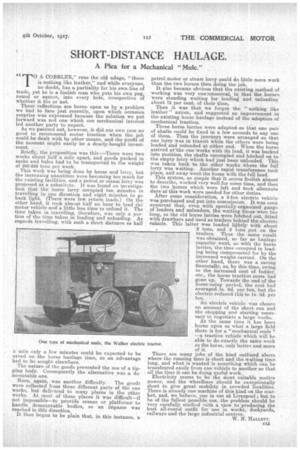SHORT-DISTANCE HAULAGE.
Page 11

If you've noticed an error in this article please click here to report it so we can fix it.
A Plea for a Mechanical "Mule,"
"T 0 A COBBLER," runs the old adage, "there is nothing like leather," and while everyone, no doubt, has a partiality for his ownline of trade, yet he is a foolish man who puts his own peg, round or square, into every hole, irrespective of whether it fits or not.
These reflections are borne upon us by a problem we had to face just recently, upon which occasion surprise was expressed because the solution we put forward was not one which our mechanical interest led another party to expect. As we pointed out, however, it did our own case no good to recommend motor traction when the job could be dealt with by other means, and the profit of the moment might easily be a dearly-bought invest ment.
Briefly, the proposition was this :—There were two works about half a mile apart, and goods packed in sacks and bales had to be transported to the weight of 200-250 tons per week.
This work was being done by horse and lorry, but the increasing quantities were becoming too much for the existing facilities, and a petrol or steam lorry was proposed as a substitute.' It was found on inaestigation that the horse lorry occupied ten minutes in travelling in one direetion and eight minutes to go back light. (There were few, return loads.) On the other hand, it took almost half an hour to load the motor vehicle and a little less time to unload it. The time taken in travelling, therefore, was only a, portion of the time taken in loading and unloading. As regards travelling, with such a short distance as half
a mile only a few minutes could be expected to be saved on the horse haulage time, so an advantage had to be sought elsewhere. "
The nature of the goods prevented the use of a tipping body. Consequently the alternative was .a demountable one.
Here, again, was another difficulty. The goods were collected from three different parts of the one works, but delivered to many places in the other works. At most of these places it was difficult—if not impossible—to provide cranes or platforms, to handle demountable bodies, so an impasse was reached in this direction.
It then began to be plain that, in this instance. a petrol motor or steam lorry could do little more work than the two horses then doing the job.
It also became obvious that the existing method of working was very uneasnomical, in that the horses were standing waiting for loading and unloading about 75 per cent. of their time.
Then it was that we forgot the "nothing like leather" axiom, and suggested an improvement in the existing horse haulage instead of the adoption of mechanical traction.
Three horse lorries were adapted so that one pair of shafts could be fixed in a few seconds to any one of them. Then the journeys were arranged so that one lorry was in transit while the others were being loaded and unloaded at either end. When the horse arrived at one works with its load, it was backed into position, the shafts uncoupled and hitched on to' the empty lorry which had just been unloaded. This was taken back to the other works where the fag lorry was waiting. Another rapid transference took place, arid away went the horse with the full load. This system, so simple that'it seems foolish almost to describe, worked very well for some time, and then the two horses which were left and took alternate days at this work were needed for other duties. • After some consideration, a. 3-ton electric vehicle
was purchased and put into commission. It was soon apparent that, even with specially-organized gang3 of loaders and u.nleaders, the waiting times were too long, so the old horse lorries were fetched out, fitted with drawbars and used as trailers behind.the electric vehicle. This latter was loaded lightly with about
2 tons, and 2 tons put on the trailers. Thus the same result was obtained, so far as haulage capacity went, as with the horse lorries, the time occupied in loading being cOmpensated for by the increased weight carried. On the other hand, there was a saving financially, as, by this time, owing to the increased cost of fodder, etc., the horse traction costs had gone up. Towards the end 4:if the horse-using period, the cost had averaged_ is. 6d. per ton, but the electric reduced this to Is. 3d. per ton.
An electric vehicle was chosen on account of the short run and the stopping and starting necessary to negotiate a large works.
At the same time it has been borne upon us what a large field there is for a "mechanical mule " —a tractive vehicle which will be able to do exactly the same work as the horse, only better and more of it.
There are many jobs of the kind outlined above where the running time is short and the waiting time long, and what is wanted is something which can be transferred easily from one vehicle to another so that all the time it can be doing useful work. Electricity seems to be the Most suitable motive power, and the wheelbase should be exceptionally short to give great mobility in crowded localities. There is already one machine of this kind on the market, and, we believe, one in use at Liverpool ; but to be of the fullest possible use, the problem should be very carefully studied vsith a view to producing the best all-round outfit for use in works, dockyards, railways and the large industrial centres. W. N. HALLETT.
























